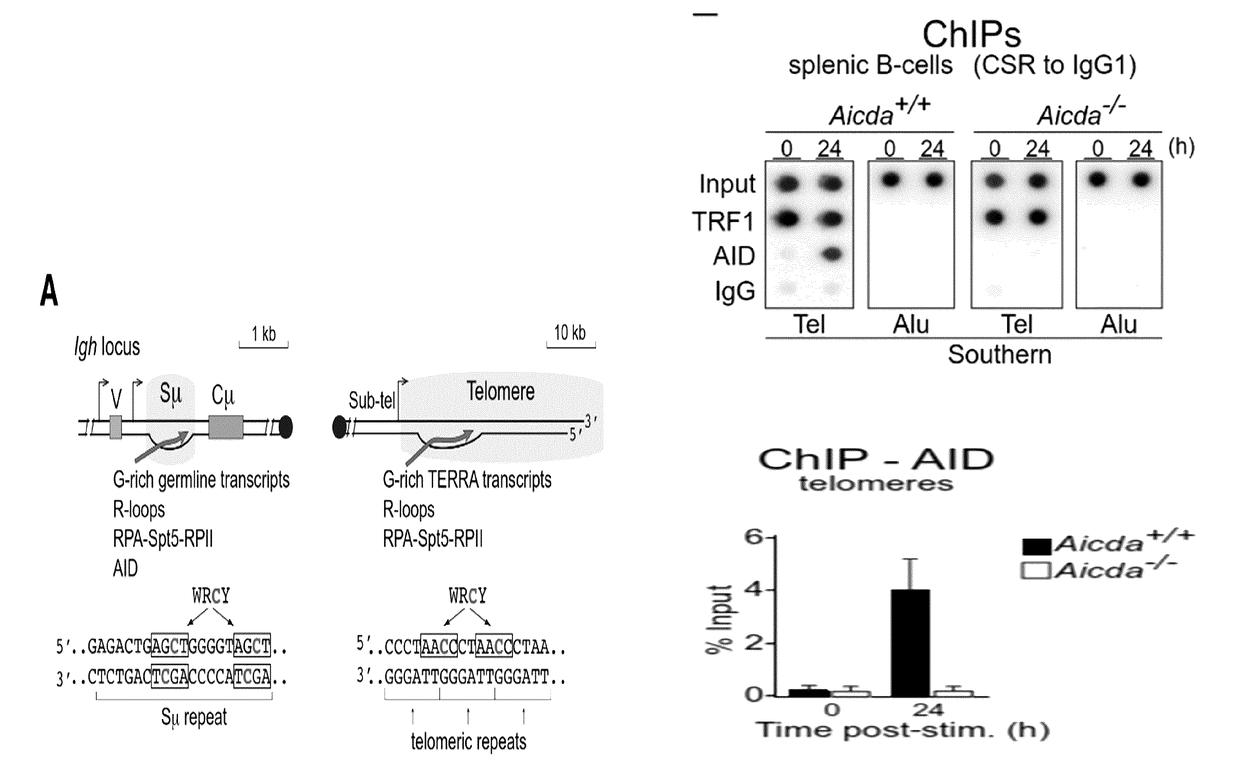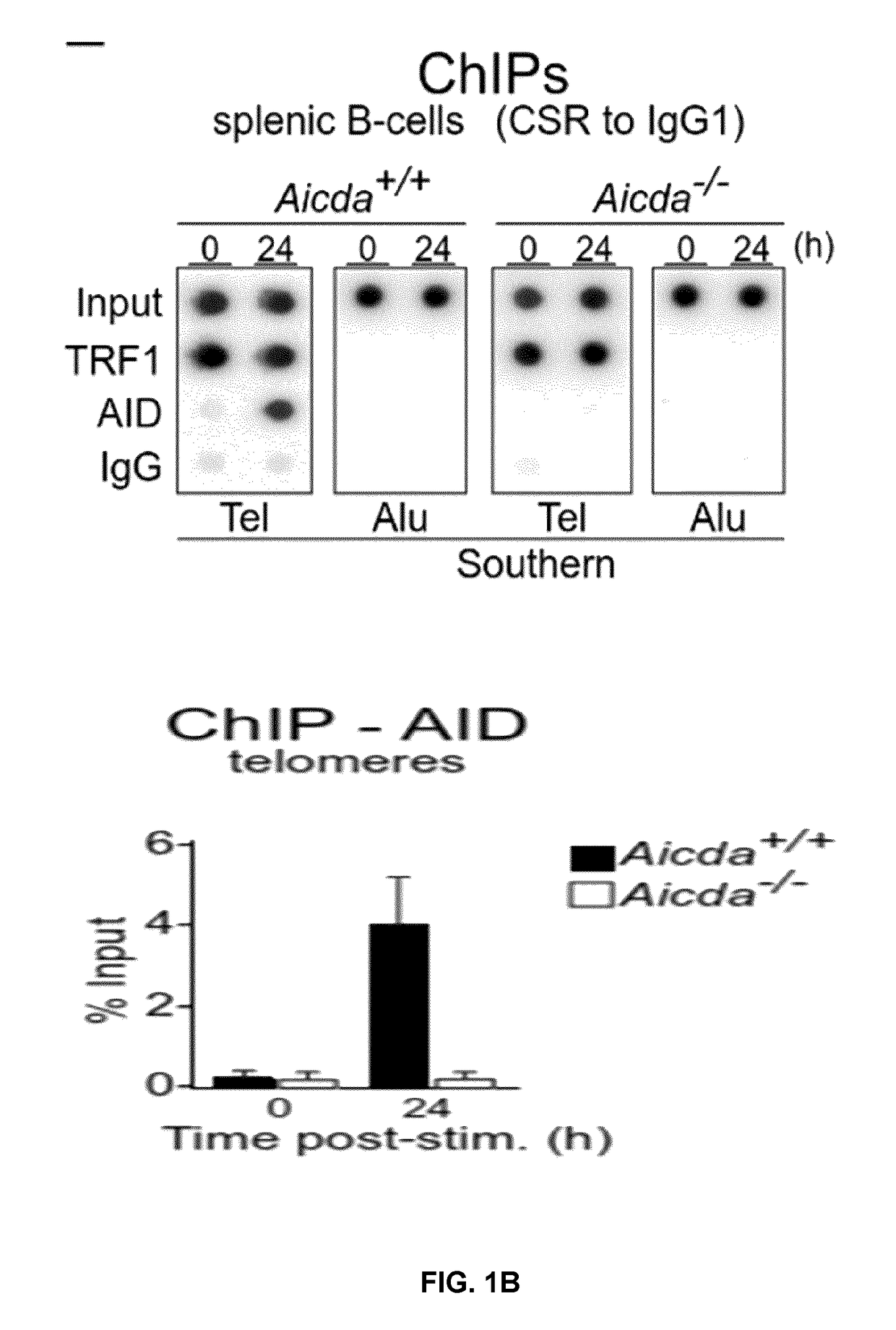Modulating uracil-dna glycosylase and uses thereof
a technology of uracildna glycosylase and uracildna sulfate, which is applied in the direction of instruments, peptide/protein ingredients, drug compositions, etc., can solve the problems of defective cell proliferation, irreversible acute telomere loss, cell proliferation defect in normal, etc., to block the proliferation of tumor b cells and reduce b cell clonal expansion
- Summary
- Abstract
- Description
- Claims
- Application Information
AI Technical Summary
Benefits of technology
Problems solved by technology
Method used
Image
Examples
example 1
Materials and Methods
[0157]Mice, mouse cohorts and immunization.
[0158]C57BL6 / J mice were from Jackson labs (Bar Harbor, Me.). and NRG mice were from Jackson labs (Bar Harbor, Me.). AID-GFPtg mice- 6, a gift of Dr R Casellas (NCI, Bethesda, Md.), Aicda− / − mice 59, a gift of Dr T Honjo (Kyoto University, Japan) and Ung− / −60, a gift from Dr H Krokan (NUST, Trondheim, Norway) were all in C57BL6 / J background. Aicda− / − Ung− / − mice were bred at the IRCM animal facility. Experimental cohorts for lymphoma follow up were observed daily for spontaneous signs of malaise or visible tumors and sacrificed when reaching one of the predefined endpoints or at 30 months old. Spleens, enlarged lymph nodes and / or any other tumors were harvested at necropsy and prepared for histology or analyzed by flow cytometry. Where indicated, mice were immunized with 50 ug of NP18-CGG (Biosearch Technologies) in Imject™ Alum adjuvant (Thermo Scientific) intra-peritoneally and analyzed by flow cytometry 8 days later....
example 2
AID at the Telomeres in Activated B Cells
[0173]The results described above suggested that AID could target telomeric DNA during CSR. In support of this, an analysis of the telomeric DNA sequence revealed the presence of a putative AID hotspot target (5′-WRCY-3′) every two telomeric repeats (FIG. 1A). Telomeres and S-regions share many similarities: both are located downstream of an RNA polymerase II (RPII) promoter producing sterile transcripts, which plays a relevant role in AID recruitment to the chromatin 3-5,18,19, and have C-rich template DNA strands enriched in AID hotspot sequences (FIG. 1A). However, unlike the DNA sequence in the S-regions of the immunoglobulin locus where hotspots for AID are present in both DNA strands, telomeres show those exclusively in the C-rich strand (FIG. 1A). Telomere transcription initiation occurs in the subtelomeric region, likely at all telomeres, and terminates within the telomeric tract, creating telomeric repeat-containing RNA or TERRA mole...
example 3
UNG Protects B Cells from AID-Dependent Telomeres Loss
[0175]Because UNG-dependent BER is involved in the faithful as well as mutagenic processing of the DNA lesions induced by AID 32,20 the inventors wanted to determine whether the observed AID-dependent toxicity in UNG-null B-cells was associated with accumulation of unrepaired DNA breaks. To test this, the inventors analyzed the chromosome integrity of B-cells deficient in UNG before and after in vitro CSR stimulation. The inventors used fluorescent in situ hybridization (FISH) to label metaphase telomeres and visualize the chromosomes ends of WT and UNG− / −splenic B-cells stimulated in vitro for CSR to IgG1. Although activated UNG− / −B-cells did not show a significant accumulation of intra-chromatid breaks the inventors observed a significant loss of telomere signals when compared to WT B-cells (FIGS. 3B, C and 4A). Indeed, Ung− / −B-cells presented ˜8-fold increase in metaphases with lost telomere signals (24% Ung− / −vs 3% WT), and ˜...
PUM
| Property | Measurement | Unit |
|---|---|---|
| Elongation | aaaaa | aaaaa |
| Therapeutic | aaaaa | aaaaa |
Abstract
Description
Claims
Application Information
 Login to View More
Login to View More - R&D
- Intellectual Property
- Life Sciences
- Materials
- Tech Scout
- Unparalleled Data Quality
- Higher Quality Content
- 60% Fewer Hallucinations
Browse by: Latest US Patents, China's latest patents, Technical Efficacy Thesaurus, Application Domain, Technology Topic, Popular Technical Reports.
© 2025 PatSnap. All rights reserved.Legal|Privacy policy|Modern Slavery Act Transparency Statement|Sitemap|About US| Contact US: help@patsnap.com



